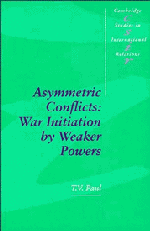Book contents
- Frontmatter
- Contents
- List of tables
- Preface
- PART I THE THEORETICAL FRAMEWORK
- PART II THE CASE STUDIES
- 3 The Japanese offensive against Russia, 1904
- 4 The Japanese attack on Pearl Harbor, 1941
- 5 The Chinese intervention in Korea, 1950
- 6 The Pakistani offensive in Kashmir, 1965
- 7 The Egyptian offensive in the Sinai, 1973
- 8 The Argentine invasion of the Falklands/Malvinas, 1982
- Conclusion
- Notes
- Bibliography
- Index
- Titles in the series
7 - The Egyptian offensive in the Sinai, 1973
Published online by Cambridge University Press: 03 May 2011
- Frontmatter
- Contents
- List of tables
- Preface
- PART I THE THEORETICAL FRAMEWORK
- PART II THE CASE STUDIES
- 3 The Japanese offensive against Russia, 1904
- 4 The Japanese attack on Pearl Harbor, 1941
- 5 The Chinese intervention in Korea, 1950
- 6 The Pakistani offensive in Kashmir, 1965
- 7 The Egyptian offensive in the Sinai, 1973
- 8 The Argentine invasion of the Falklands/Malvinas, 1982
- Conclusion
- Notes
- Bibliography
- Index
- Titles in the series
Summary
The Egyptian offensive in the Sinai in 1973 provides a test case of an asymmetric conflict in which the relatively weak side initiated the war. The Egyptian leadership was well aware of the Israeli superiority in the air and on the ground – the two crucial determinants of military power in the Middle Eastern strategic context – when it undertook the attack. In other indicators of military and economic capability, despite the disadvantage in terms of total population (Egypt's was ten times greater), Israel could still muster a larger pool of skilled human resources than Egypt. As a result of the 1967 War, Israel assumed a better geo-strategic position than its Arab opponents, as it could deploy forces deep into Sinai. In terms of economic power, both states had a gross national product of approximately $7 billion, although the Israeli per capita income remained much higher than that of Egypt.
In more tangible indicators of military capability, Israel held advantages in air power, especially in deep penetration and reconnaissance capability, close air support, and tactical air-lift, as well as in armor and other ground weapons. The Israeli soldiers were better trained in the handling of sophisticated weaponry and were better marksmen than their Egyptian counterparts. The technological superiority of Israel in 1973 also enabled it to possess much greater firepower than Egypt.
- Type
- Chapter
- Information
- Asymmetric ConflictsWar Initiation by Weaker Powers, pp. 126 - 145Publisher: Cambridge University PressPrint publication year: 1994



